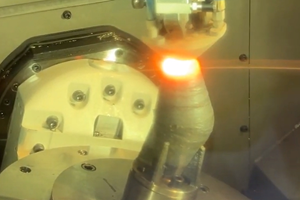Software And Five-Axis Machining Center Provide Speed And Efficiency
Mold maker A.F. Gaskin (Buckinghamshire, United Kingdom) has customers who operate in fiercely competitive international markets, including Formula 1, and measure performance on the ability to deliver quality products in the shortest possible time.
Share






Mold maker A.F. Gaskin (Buckinghamshire, United Kingdom) has customers who operate in fiercely competitive international markets, including Formula 1, and measure performance on the ability to deliver quality products in the shortest possible time. With increasing pressure on lead times, the company realized it needed the speed and efficiency advantages offered with five-axis machining. "We need this technology to produce the tools our customers require," says production and quality director David Gaskin. "It is essential to the long term future of the business."
Using a five-axis Deckel Maho (Pfronten, Germany) DMU80P machining center with PowerMill machining software from Delcam (Birmingham, United Kingdom) proved to be a quick solution for A.F. Gaskin. Within 10 days of installation at the company's site, the new machine was cutting a complex core in fully-hardened tool steel.
The flexibility of the DMU80P, when combined with the PowerMill software, enables users to examine new machining strategies that can maximize productivity, explains Ray Gibbs, production manager. "Since there are no time or quality penalties in repositioning the work, we are able to exploit the advantages of machining using multiple work planes," says Mr.Gibbs. Using our Delcam software, we can look at a job and work out how it can be positioned in such a way that we can maximize tool access.
"The result has been that we can machine the surface in areas that would previously have been impossible to access economically. In addition, difficult surfaces that would have needed long series cutters are now simple. Easier access is allowing us to use shorter tools resulting in improved surface finish and a reduction in the number of post machining operations, including EDM."
Mr. Gaskin continues: "If we don't have to use the EDM machine, we don't have to produce an electrode first. This saves a lot of time and money, so the more we can machine in one hit, the better." In the future, the company also plans to gun drill water holes in the same setup as machining the 3D form to further improve productivity and increase the value-added on the machine.
Mr. Gibbs also points out another real benefit of five-axis machining that was not part of the original purchasing decision but has become apparent with use. Even though the machine was operating at a higher work rate and using faster speeds and feeds, the increase in productivity was accompanied by improved tool life. Mr. Gibbs' explanation is that they could avoid using only the bottom of the cutter and thus have more efficient machining and more even wear over the cutting surface.
Along with the existing CNC machining centers, the new DMU 80P has increased the company's hard metal cutting capacity by 50 percent. All machining is controlled by the CAM department, which now contains five seats of Delcam's PowerMill, PowerShape and PowerInspect software. The latest PowerMill system has been installed on a PC on the shop floor, allowing cutter path programming next to the machine tools. "This helps our efficiency by giving the programmers a close and visual link to all the CNC machines," Mr. Gaskin says.
The company has developed a section, within the design and CAM departments, to design electrodes used in the manufacture of molds. These electrodes are designed using PowerShape, machined with PowerMill and inspected using PowerInspect. This gives the confidence that the 3D surfaces machined are in the correct position and within the correct tolerances. "It is essential that all electrodes are inspected to ensure that our high quality is maintained and to prevent any costly errors," Mr. Gaskin says. "PowerInspect is simple to use and produces reports that are easy to interpret."
Related Content
Additive/Subtractive Hybrid CNC Machine Tools Continue to Make Gains (Includes Video)
The hybrid machine tool is an idea that continues to advance. Two important developments of recent years expand the possibilities for this platform.
Read MoreInside a CNC-Machined Gothic Monastery in Wyoming
An inside look into the Carmelite Monks of Wyoming, who are combining centuries-old Gothic architectural principles with modern CNC machining to build a monastery in the mountains of Wyoming.
Read MoreOrthopedic Event Discusses Manufacturing Strategies
At the seminar, representatives from multiple companies discussed strategies for making orthopedic devices accurately and efficiently.
Read MoreHow to Determine the Currently Active Work Offset Number
Determining the currently active work offset number is practical when the program zero point is changing between workpieces in a production run.
Read MoreRead Next
Machine Shop MBA
Making Chips and 91ÊÓƵÍøÕ¾ÎÛ are teaming up for a new podcast series called Machine Shop MBA—designed to help manufacturers measure their success against the industry’s best. Through the lens of the Top Shops benchmarking program, the series explores the KPIs that set high-performing shops apart, from machine utilization and first-pass yield to employee engagement and revenue per employee.
Read MoreAMRs Are Moving Into Manufacturing: 4 Considerations for Implementation
AMRs can provide a flexible, easy-to-use automation platform so long as manufacturers choose a suitable task and prepare their facilities.
Read More




















